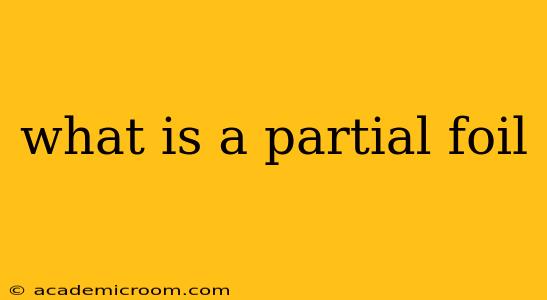What is a Partial Foil? Understanding Literary Foil Characters
A partial foil is a character who shares some similarities with another character but also possesses significant differences, creating a nuanced comparison rather than a direct contrast. Unlike a complete foil, which acts as a mirror image highlighting specific traits of the protagonist, a partial foil offers a more complex and subtle comparison, enriching our understanding of both characters involved. This allows for a deeper exploration of themes and character development within the narrative.
Think of it like this: a complete foil is a black and white photograph – clear-cut differences are immediately apparent. A partial foil, however, is a more complex image, perhaps a sepia tone photo, where similarities and differences blend subtly, requiring closer examination to fully appreciate the contrast.
How does a partial foil differ from a complete foil?
A complete foil is a character who directly contrasts with the protagonist in almost every significant aspect. Their traits are diametrically opposed, making the protagonist's characteristics stand out in sharp relief. For example, a brave hero might be contrasted with a cowardly villain. The differences are stark and immediately obvious.
A partial foil, on the other hand, shares some key similarities with another character while also diverging in other crucial aspects. This creates a more intricate comparison, allowing for a more nuanced understanding of both characters' personalities and motivations. The differences are not as stark, but rather highlight specific areas of divergence that are crucial to the narrative.
What are some examples of partial foils in literature?
Let's consider a few examples to illustrate the concept:
-
In Hamlet, Horatio acts as a partial foil to Hamlet. Both are intelligent and thoughtful, but Horatio maintains a level of emotional stability and objectivity that Hamlet lacks. Horatio's calm rationality contrasts with Hamlet's volatile emotional turmoil, highlighting the latter's internal struggles. However, both share a deep loyalty to Hamlet's father and a desire for justice.
-
Consider the characters of Elizabeth Bennet and Charlotte Lucas in Pride and Prejudice. Both are intelligent and navigate the complexities of societal expectations, but they contrast greatly in their approaches to marriage and societal pressures. Elizabeth prioritizes love and personal fulfillment, while Charlotte chooses security and social standing. The partial foil highlights different approaches to female empowerment and autonomy during that era.
-
Many works of fiction utilize sibling relationships to create partial foils. Siblings often share a common background and upbringing but forge distinct paths in life, developing different personalities and worldviews. Their contrasting choices and outcomes highlight the impact of individual choices and the complexities of familial relationships.
How do partial foils enhance storytelling?
Partial foils significantly enrich the narrative by:
- Adding depth and complexity to characters: They go beyond simplistic good versus evil portrayals, presenting characters with multifaceted personalities and motivations.
- Developing thematic explorations: The subtle contrasts highlight key themes within the story, fostering deeper reflection and understanding.
- Creating more realistic characters: People are rarely completely different or completely alike; partial foils mirror this reality, making characters more relatable and believable.
- Generating dramatic tension and conflict: The similarities and differences between characters create intriguing dynamics and conflict within the story.
Understanding the concept of a partial foil allows for a deeper appreciation of character development and thematic exploration in literature. By recognizing the subtle yet significant contrasts between characters, we gain a richer understanding of the narrative as a whole.
